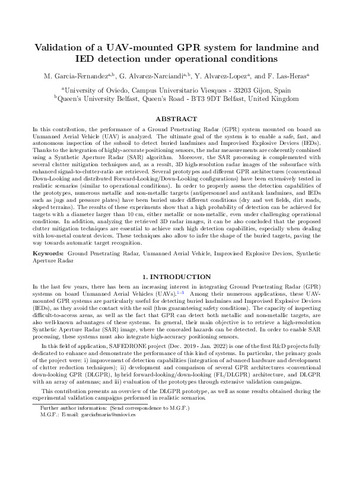Validation of a UAV-mounted GPR system for landmine and IED detection under operational conditions
Palabra(s) clave:
Drones
Telecomunicaciones
Ground penetrating radar
Subsurface imaging
Fecha de publicación:
Editorial:
International Society for Optics and Photonics
Versión del editor:
Descripción física:
Resumen:
In this contribution, the performance of a Ground Penetrating Radar (GPR) system mounted on board an Unmanned Aerial Vehicle (UAV) to detect buried landmines and Improvised Explosive Devices (IEDs) is analyzed. Radar measurements are coherently combined using a Synthetic Aperture Radar (SAR) algorithm complemented with several clutter mitigation techniques. As a result, 3D high-resolution radar images of the subsurface with enhanced signal-to-clutter-ratio are retrieved. Several prototypes and different GPR architectures have been extensively tested in realistic scenarios, where numerous metallic and non-metallic targets (landmines and IEDs) have been buried under different conditions (dry and wet fields, dirt roads, sloped terrains).
In this contribution, the performance of a Ground Penetrating Radar (GPR) system mounted on board an Unmanned Aerial Vehicle (UAV) to detect buried landmines and Improvised Explosive Devices (IEDs) is analyzed. Radar measurements are coherently combined using a Synthetic Aperture Radar (SAR) algorithm complemented with several clutter mitigation techniques. As a result, 3D high-resolution radar images of the subsurface with enhanced signal-to-clutter-ratio are retrieved. Several prototypes and different GPR architectures have been extensively tested in realistic scenarios, where numerous metallic and non-metallic targets (landmines and IEDs) have been buried under different conditions (dry and wet fields, dirt roads, sloped terrains).
Patrocinado por:
This work has been funded by the Spanish Ministry of Defense and the University of Oviedo (contract 2019/SP03390102/00000204); by the Spanish Ministry of Science and Innovation (RTI2018-095825-B-I00 and PID2021-122697OB-I00), by the Spanish Ministry of Universities and European Union -NextGenerationEU-(MU-21-UP2021-030-53519863 and MU- 21-UP2021-030-71667225), and by Gobierno del Principado de Asturias/FEDER (AYUD/2021/51706).
Colecciones
Ficheros en el ítem




